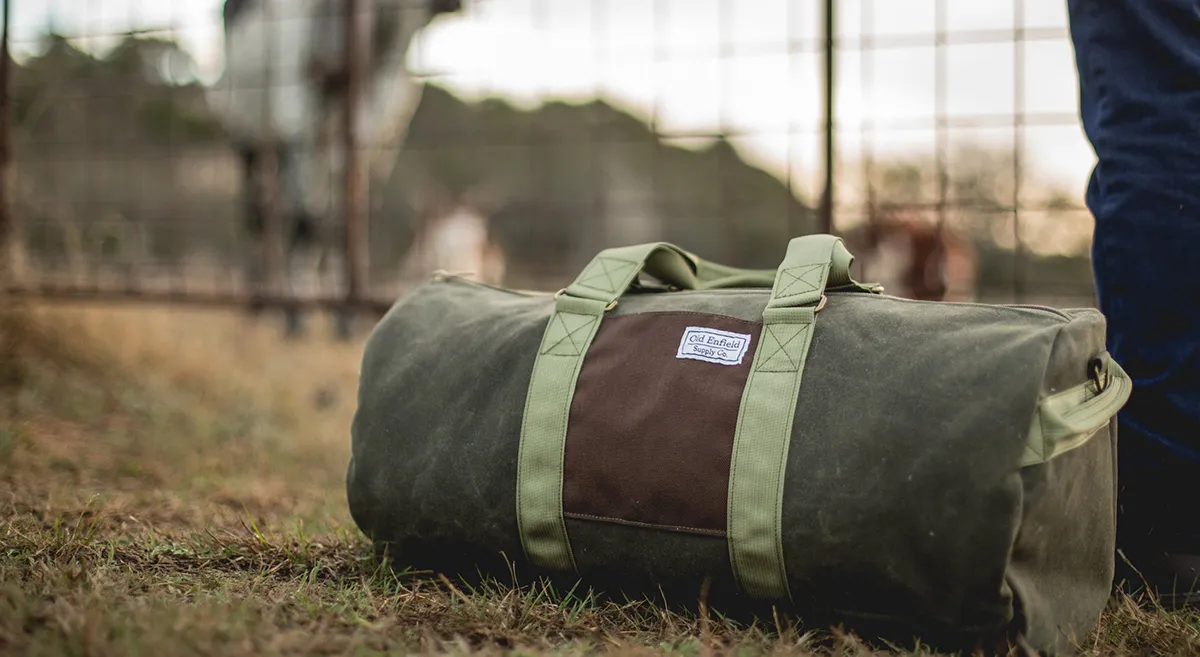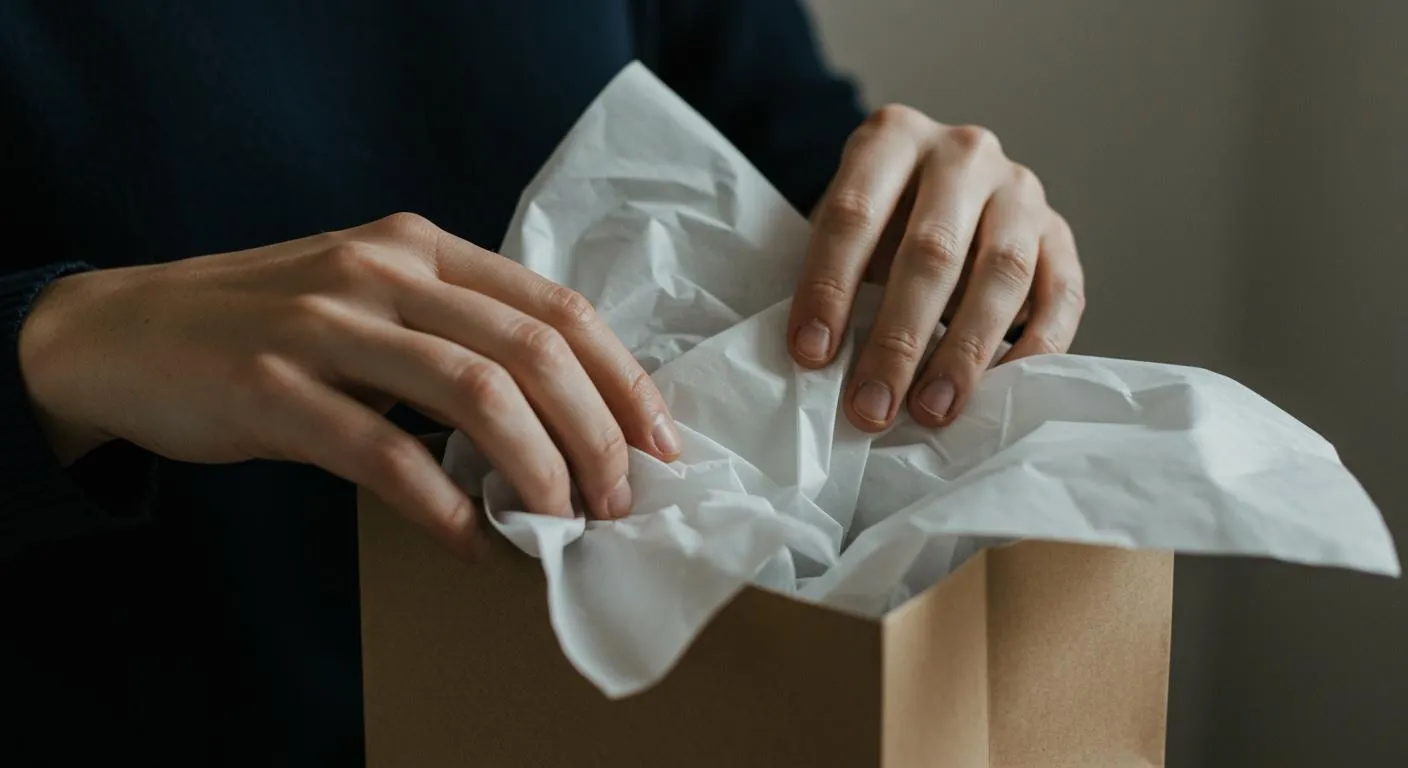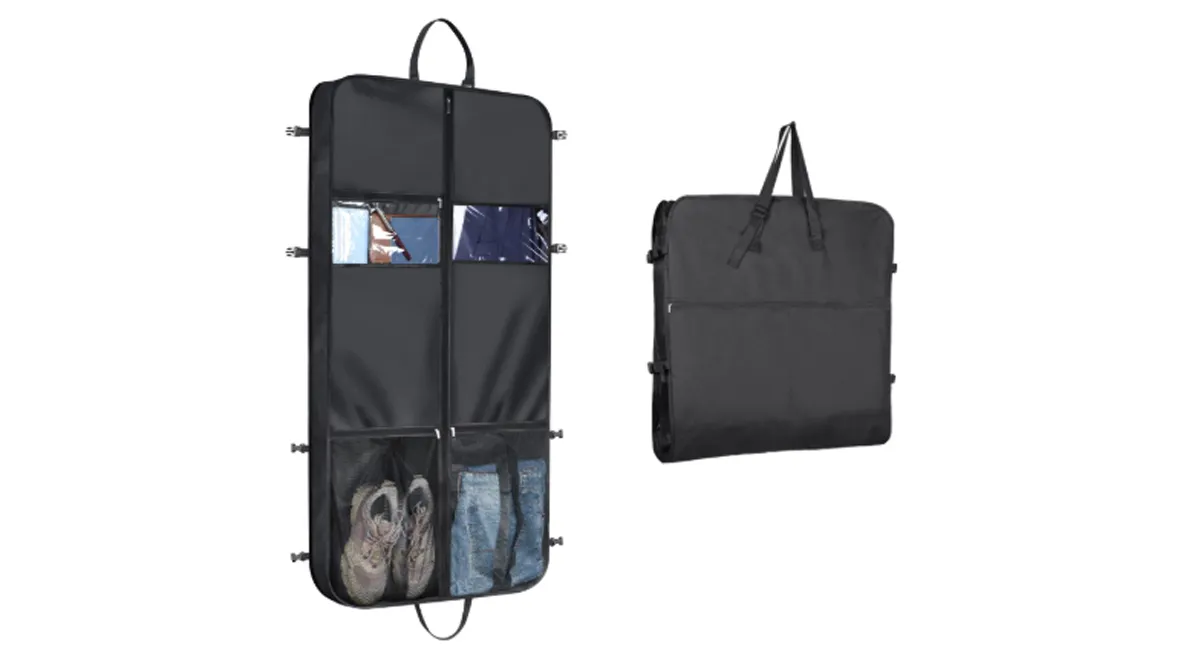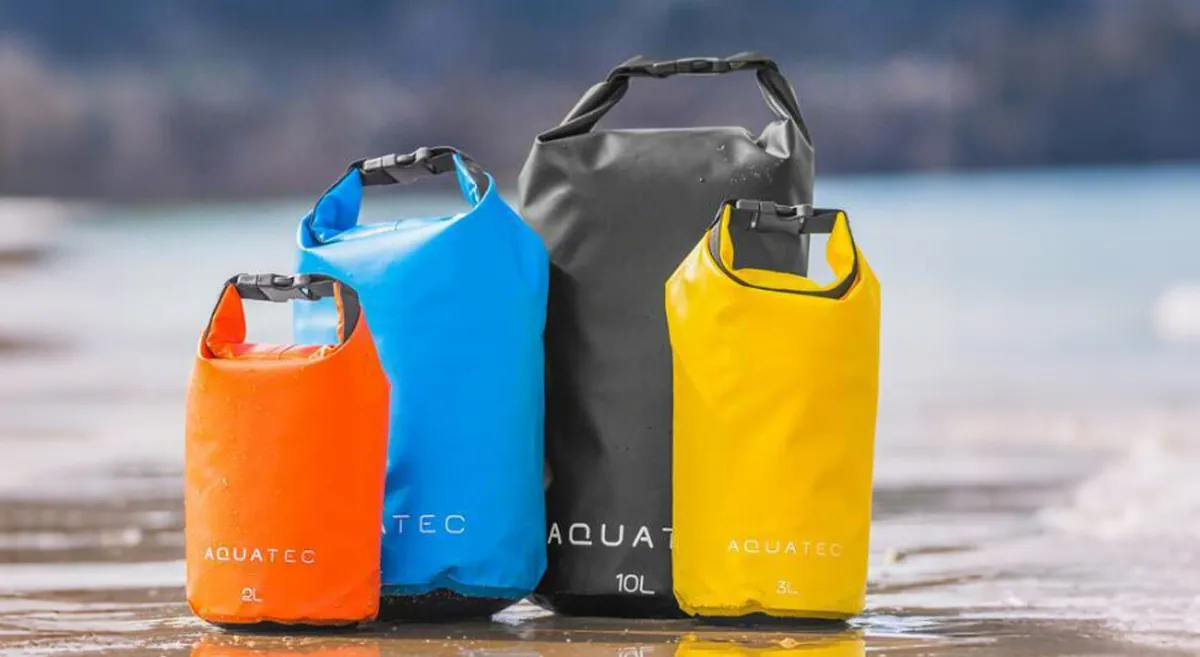
You might wonder what is a dry bag and why you see it everywhere when packing for outdoor adventures. A dry bag keeps your gear safe from water, whether you go kayaking or hiking in the rain. Many outdoor fans say dry bags protect their stuff better than regular waterproof bags. Just look at the numbers:
| What Happens When You Use a Dry Bag? | Result |
|---|---|
| People who say dry bags prevent damage | 88% |
| Gear stays dry after 30 minutes underwater | 100% |
You want your phone, clothes, and snacks to stay dry. With a dry bag, you get peace of mind.
Key Takeaways
- A dry bag helps keep your things dry outside. You can use it when kayaking, hiking, or camping. The roll-top closure makes a tight seal. This keeps water out and your stuff safe. Dry bags use waterproof materials like PVC and nylon. These materials stop water from getting in. Pick a dry bag size that fits what you need. Small bags work for electronics. Bigger bags hold camping gear. Check the seams and closures often. Make sure they are tight and working well. Dry bags are not only for water sports. You can use them every day and when you travel. They protect your things from spills and rain. Take care of your dry bag by cleaning and air drying it. This helps it last longer and stay waterproof. Always look at the waterproof rating before you buy. Make sure it is good for your adventure.
What Is a Dry Bag
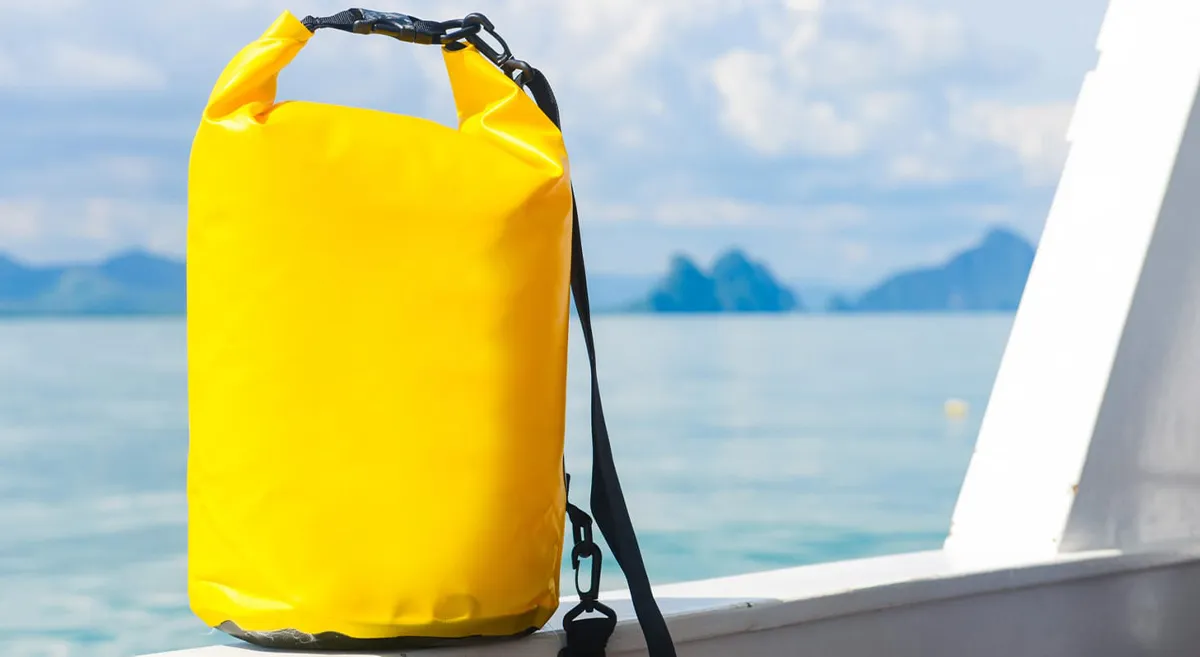
Definition
You might ask yourself, what is a dry bag? You see this term often when you start packing for outdoor trips. A dry bag is a special kind of bag designed to keep your gear dry, even when you face rain or splashes. The outdoor equipment industry says dry bags are essential for activities like kayaking and sailing. You use them because they are waterproof and protect your items from water damage. You can trust a dry bag to keep your phone, clothes, and snacks safe when you are near water.
- Designed to be waterproof
- Protects items from water damage
- Commonly used in outdoor activities such as kayaking, canoeing, and camping
Shape and Design
When you look at a dry bag, you notice its simple shape. Most dry bags have a cylindrical body. This shape makes it easy to pack your gear and roll the top closed. You find roll-top closures on almost every dry bag. These closures clip to the side or to themselves at the top, sealing out water. Handles sit centered on the side for balance, and some bags offer multiple handles for easy carrying. You also get extra width in many dry bags, so you can fit more items and remove them easily.
| Feature | Description |
|---|---|
| Dimensions | 38 in by 38 in by 3.94 in, with 1 inch clearance for item removal. |
| Handle Location | Centered on the side for balance, with options for multiple handles. |
| Closure Type | Roll type closures that either clip to the side or to themselves at the top. |
| Extra Size Consideration | Includes 2 extra inches of width for ease of use and fitting items. |
Tip: Always check the closure before you head out. A tight roll-top keeps water out and your gear dry.
Common Uses
You use a dry bag for more than just kayaking. Many people rely on dry bags for camping, hiking, and organizing gear. You can pack clothes, electronics, and food inside, knowing they will stay dry. Dry bags work well for canoe trips, beach days, and even rainy commutes. You might use one to separate wet and dry items or to keep your valuables safe from water. When you want reliable waterproof protection, you reach for a dry bag.
How Dry Bags Work
You want to know how a dry bag keeps your gear safe from water. The secret comes from three things: waterproof materials, a smart roll-top closure, and strong seam construction. Let’s break down each part so you can see why these bags work so well.
Waterproof Materials
The first thing you notice about a dry bag is the tough, waterproof fabric. This material blocks water from getting inside. Different bags use different fabrics, and each one has its own strengths.
| Material | Waterproof Rating | Best Use Cases |
|---|---|---|
| PVC | IPX6–8 (welded) | Rafting bags, marine gear, industrial dry bags |
| TPU | IPX7–8 (welded) | High-end backpacks, bike bags, technical dry sacks |
| Ripstop Nylon | IPX4–6 (coated) | Hiking daypacks, ultralight roll tops, travel gear |
| Polyester | IPX4–6 (coated) | Casual dry bags, foldable totes, promotional packs |
| RPET | IPX4–6 (coated) | Eco-lifestyle bags, green-conscious travel packs |
| Trilaminate | IPX8+ (sealed seams) | Tactical/military bags, expedition dry packs |
| PU Leather | IPX3–4 (surface only) | Fashionable backpacks, city commuter bags |
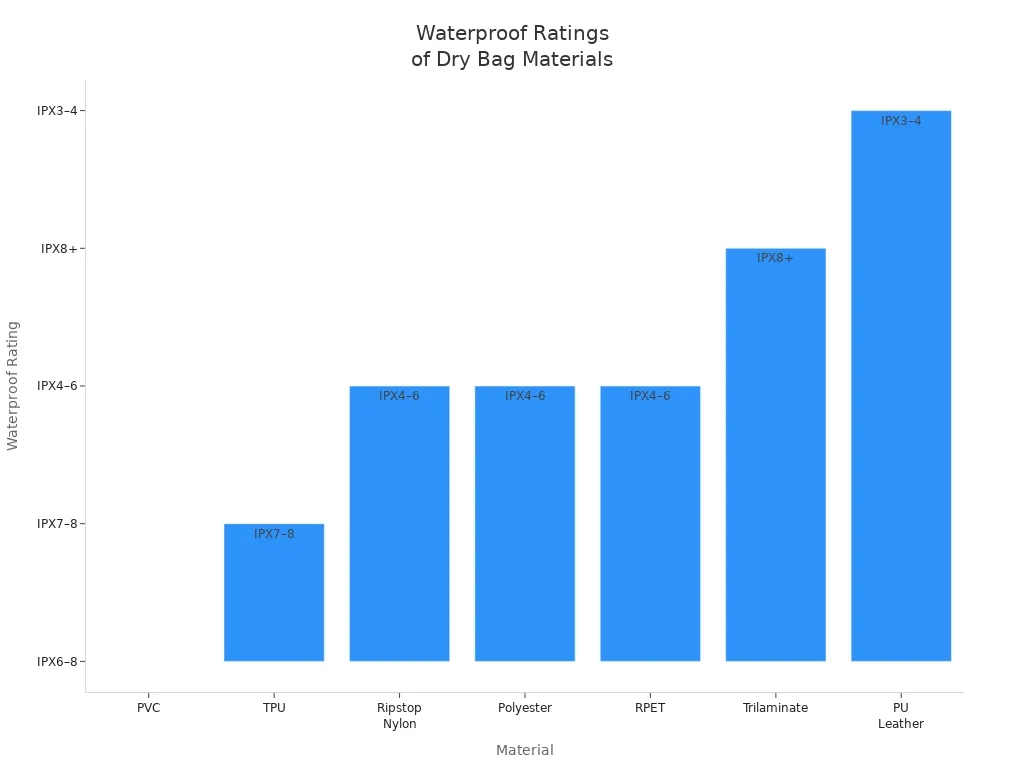
PVC
PVC stands for polyvinyl chloride. You see this material in many dry bags for water sports and outdoor work. PVC gives you a high level of waterproof protection. It feels thick and strong. You can trust it to keep water out, even if you drop your bag in a river.
Nylon
Nylon is another popular choice. Makers often coat nylon with PU (polyurethane) to boost its waterproof power. Ripstop nylon is light and tough. You find it in hiking and camping bags. It works well for travel because it keeps your gear dry but does not add much weight.
Coated Vinyl
Coated vinyl is smooth and flexible. It gives you a waterproof barrier that stands up to splashes and rain. You see coated vinyl in bags for boating and beach trips. It is easy to clean and lasts a long time.
Note: When you pick a dry bag, check the waterproof rating. Higher numbers mean better protection against water.
Roll-Top Closure
The roll-top closure is what makes a dry bag special. You do not just zip it shut. You roll the top down several times and then clip or buckle it. This creates a watertight seal that keeps water out, even if you dunk the bag.
The roll-top design works like this:
- Fill your bag but leave a small air pocket at the top (about 2–3 inches).
- Squeeze out extra air to make the bag less bulky.
- Fold the top edge over itself at least three times.
- Clip or buckle the ends together. This compresses the folded material and forces water to flow around, not through, the closure.
Tip: Always roll the top at least three times. This is one of the packing best practices for keeping your gear dry.
Other closure types, like zippers, can fail if you submerge the bag. The roll-top gives you more reliable waterproof protection.
Seam Construction
Even the best waterproof fabric will not help if water leaks in through the seams. That is why dry bags use special seam construction. Makers use heat welding or strong adhesives to seal the seams. This stops water from sneaking in.
| Test Name | Description |
|---|---|
| Hydrostatic Head Test | Measures how much water pressure the fabric can handle before leaking. Higher numbers mean better protection. |
| IP Rating Assessment | Shows how well the bag stands up to water using a special rating system. |
| Leak Test | Fills or submerges the bag to check for leaks in seams and zippers. |
| Seam and Material Inspection | Checks for defects in seams and materials. Makers use adhesives or heat to seal these areas. |
You want seams that pass these tests. This means your bag will keep your phone, clothes, and snacks dry, even in heavy rain or if you drop it in water.
Remember: A dry bag works best when you use all three features together—waterproof fabric, a roll-top closure, and sealed seams. This combo gives you the watertight seal you need for any adventure.
Dry Bag Features
Durability
When you pick up a dry bag, you want it to last through every adventure. Durability matters most when you face rough trails, sharp rocks, or heavy rain. Most dry bags use waterproof fabric that resists tears and punctures. You can toss your bag in a canoe or drag it across a campsite without worrying about damage. The tough material stands up to sun, mud, and even saltwater. Many bags also have reinforced bottoms and seams. These features help the bag keep its shape and strength, even after years of use. If you need a bag that can handle anything, look for one with double-stitched seams and a thick, rugged feel. A strong bag means you can trust it to protect your gear, no matter where you go.
Tip: Always check the seams and closure before heading out. A good seal keeps your items safe from water.
Buoyancy
Have you ever dropped your bag in a river or lake? You want it to float, not sink. Dry bags are designed to stay on top of the water, even when fully loaded. Some brands, like Watershed, add special features such as an Oral Inflation Tube. This tube lets you add or release air, so you can adjust how much the bag floats. Many other waterproof storage solutions do not offer this. They might leak or sink if you submerge them for too long. Watershed bags stand out because they keep your gear dry during long periods underwater. Their buoyancy gives you extra peace of mind when you travel by boat or cross streams. You can spot your bag easily if it falls in, and you know your things will stay dry inside.
Size Options
You do not need the same size bag for every trip. Dry bags come in many sizes, so you can pick the right one for your adventure. Here is a quick guide to help you choose:
- 2-Liter Dry Bags: Perfect for small items like wallets, keys, and phones. Great for day hikes or short outings.
- 5-Liter Dry Bags: Good for snacks, a first aid kit, or an extra shirt. Handy for day trips or short backpacking adventures.
- 10-Liter Dry Bags: Fits a change of clothes or a light jacket. Works well for weekend trips or multi-day hikes.
- 20-Liter Dry Bags: Holds bigger items like a sleeping bag or several outfits. Best for longer journeys.
- 30-Liter and Larger Dry Bags: Carries bulky gear for extended outdoor adventures.
You can mix and match sizes to organize your packing. Use a small bag for electronics and a larger one for clothes or food. This way, you keep everything dry and easy to find. No matter what you pack, you get a watertight seal that protects your gear from water and rain.
Portability
When you pack for an outdoor trip, you want your gear to be easy to carry. That’s where the portability of a dry bag really shines. You don’t want to lug around a heavy, bulky bag when you’re hiking up a trail or paddling across a lake. Dry bags make your life easier because they’re designed with travel in mind.
Most dry bags use lightweight materials. You can toss one in your backpack or strap it to your kayak without feeling weighed down. Even the heavy-duty models keep things light. This means you can bring more of what you need—like snacks, clothes, or a camera—without worrying about extra weight.
Let’s look at some features that boost portability and how they help you:
| Feature | Benefit |
|---|---|
| Lightweight Design | Makes it easy for you to carry, even on long hikes or trips. |
| Variety of Sizes | Lets you pick the perfect bag for your gear, so you never carry too much or too little. |
| Durable Construction | Handles rough use, so you don’t have to worry about rips or tears while you’re on the move. |
You’ll notice that dry bags come in all shapes and sizes. You can find tiny ones for your phone or wallet, and big ones for sleeping bags or extra clothes. This variety means you can choose the right size for every adventure. If you’re just heading out for a quick paddle, grab a small bag. If you’re camping for the weekend, pick a larger one. You can even use several bags to organize your stuff. That way, you always know where everything is.
Here are some reasons why dry bags are so easy to take anywhere:
- Heavy-duty yet lightweight design keeps your load manageable.
- Durable and easy to carry, even when packed full.
- Keeps your belongings safe and dry, no matter the weather or terrain.
Many dry bags also have handy features like adjustable straps or handles. You can sling one over your shoulder or attach it to your backpack. Some bags even have backpack-style straps, so you can carry them hands-free. This makes it simple to move from your car to the campsite or from the dock to your boat.
Tip: When you pack your dry bag, leave a little air inside before sealing it. This not only helps with buoyancy but also makes the bag easier to grab and carry.
You don’t have to worry about your bag getting in the way. Dry bags fit into tight spaces, tuck under seats, or clip onto your gear. Their flexible shape lets you squeeze them into backpacks or storage bins. Whether you’re hiking, biking, or paddling, you’ll find that a dry bag goes wherever you go—without slowing you down.
Waterproof vs Water-Resistant
Key Differences
You might see the words “waterproof” and “water-resistant” on bags and wonder what they really mean. These terms sound similar, but they offer very different levels of protection. Let’s break it down so you can pick the right bag for your next adventure.
Here’s a simple table to help you see the main differences:
| Type | Waterproof Bags | Water-Resistant Bags |
|---|---|---|
| Common Materials | PVC, TPU, Gore-Tex | Treated Nylon, Polyester |
| Seam Construction | Welded Seams, Fully Taped Seams | Flat Seams, Taped Seams |
| Performance | Complete protection against water | Protection against light rain and splashes |
A waterproof bag keeps your gear dry even if you drop it in a river or get caught in a heavy storm. You can trust it for extreme conditions. These bags use strong materials like PVC or TPU and have welded seams that block out water completely.
A water-resistant bag helps in light rain or if you get splashed. It uses treated nylon or polyester and may have taped seams, but it cannot handle being soaked or submerged. If you use a water-resistant bag in a downpour, your stuff might get wet.
Here’s a quick list to help you remember:
- Waterproof bags: Best for full protection, even underwater or in heavy rain.
- Water-resistant bags: Good for light rain, but not for long exposure to water.
Tip: Always check the label before you buy. If you need real protection, choose a waterproof bag.
Why Waterproof Matters
You want to keep your gear safe and dry, especially when you love outdoor activities. Waterproof protection is not just a bonus—it’s a must for many adventures. Imagine hiking in the rain, crossing a river, or paddling a kayak. If your bag is not waterproof, your clothes, electronics, and food can get soaked. This can ruin your trip and even put you at risk.
Waterproof bags give you peace of mind. They protect your phone, camera, and dry clothes from water damage. You do not have to worry about sudden weather changes or dropping your bag in a stream. For activities like kayaking, fishing, or camping, a waterproof bag keeps your essentials dry and safe.
If you use only a water-resistant bag, you might be okay in a light drizzle. But if the rain gets heavy or you fall in the water, your gear could get wet. This can lead to ruined electronics, soggy clothes, and even safety problems if you lose important items.
- Kayaking, surfing, and boating need waterproof bags to keep gear dry.
- Camping and trekking trips require dry gear, especially for electronics.
- Fishing trips demand bags that can handle splashes or even being dropped in the water.
Note: When you choose a bag for your next adventure, think about where you’ll go and what you need to protect. Waterproof protection can make all the difference.
Construction
Fabric Types
When you pick a dry bag, you want to know what it’s made of. The fabric matters because it affects how light, strong, and waterproof your bag will be. Here’s a quick look at the most common fabrics you’ll find in dry bags:
| Fabric Type | Advantages | Disadvantages |
|---|---|---|
| PU Coated Nylon | Lightweight, great for hiking and camping. | Not as tough as some other fabrics. |
| Dyneema® Composite Fabric | Super strong for its weight, waterproof, and eco-friendly. | Costs more than most fabrics. |
| Nylon Ripstop | Resists tears, light to carry, can be treated to block water. | Needs extra treatment to be fully waterproof. |
You might choose PU coated nylon if you want a light bag for a day hike. Dyneema® works well when you need something strong and don’t mind paying extra. Nylon ripstop is a favorite for many because it’s tough and easy to carry.
Tip: If you want the best mix of strength and weight, look for bags with Dyneema® or ripstop nylon.
Seam Sealing
The seams on your dry bag are just as important as the fabric. If water can sneak in through the seams, your gear gets wet. Dry bag makers use different ways to seal seams. Some work better than others.
| Seam Type | Example Brand | Waterproof Level | Cost | Durability |
|---|---|---|---|---|
| Stitched only | Low-end luggage | Low | Low | Medium |
| Stitched + Tape | Thule Chasm | Medium (IPX4–5) | Medium | Medium |
| RF/HF Welding | Ortlieb | High (IPX6–7) | Higher | High |
| Ultrasonic Welded | YETI Panga | Very High (IPX7–8) | Highest | Very High |
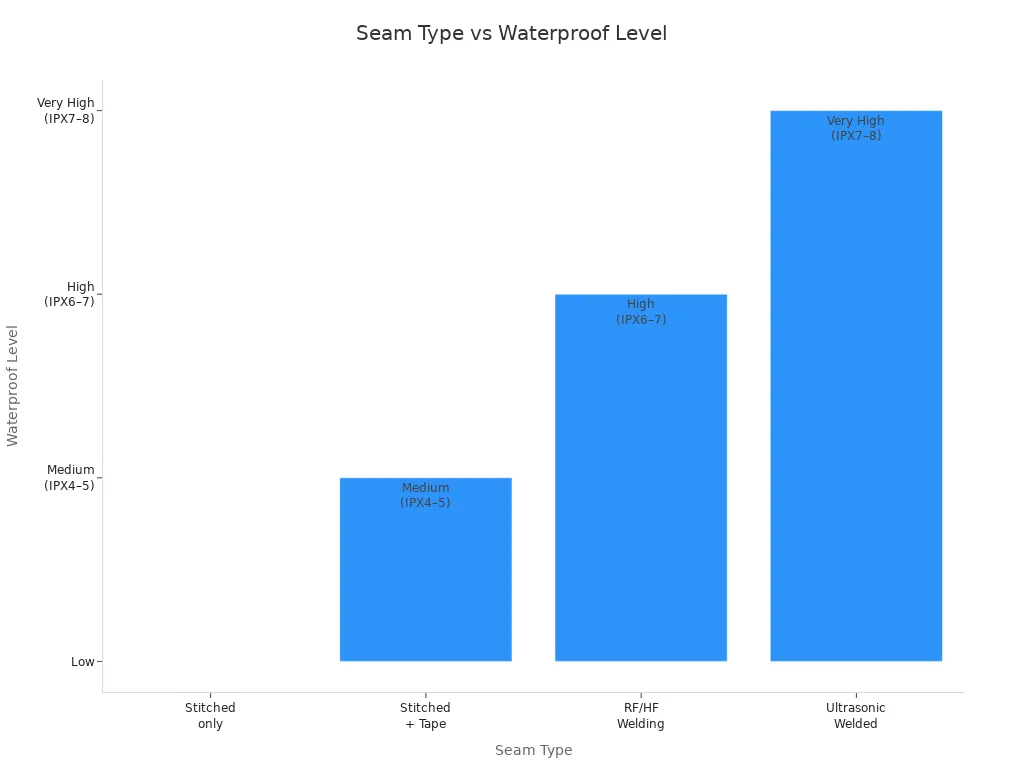
You’ll see a few main types of seams:
- Stitched Seams: These are the cheapest. They use a needle and thread, but the needle makes tiny holes. Water can leak through these holes.
- Seam Taping: Makers add tape over the stitches. This helps block water, but the tape can peel off after a while.
- Welding Technologies: These use heat or sound waves to melt the fabric together. No holes, so water stays out. These seams last longer and keep your gear dry, even if you drop your bag in a river.
Note: If you want the best waterproof protection, pick a bag with welded seams.
Testing
You want to trust your dry bag before you take it outside. That’s why companies test their bags in real-life ways. Here’s how they do it:
- They fill the bag with paper and dunk it in water for five hours. If the paper stays dry, the bag passes.
- Some tests put the bag in a bathtub or even take it on a kayak trip through rapids.
- After each test, they check for leaks by looking at the paper inside.
You can try a simple test at home. Put a dry towel inside your bag, close it tight, and submerge it in your sink or bathtub. If the towel stays dry, your bag is ready for adventure.
Pro Tip: Always check your bag for leaks before a big trip. A quick test can save your gear from getting soaked!
Why Use a Dry Bag
Protecting Valuables
You want your phone, camera, and clothes to stay safe when you travel. A dry bag gives you reliable protection against water. You can toss your electronics inside and trust that they will stay dry, even if you get caught in a downpour or drop your bag in a stream. Many people use dry bags for waterproof gear because they know accidents happen. You might spill your drink or get splashed during a hike. With a dry bag, you keep your valuables secure and dry. Packing your items in a dry bag means you do not have to worry about water damage. You can focus on your adventure instead of stressing about your stuff.
Tip: Always double-check the closure before heading out. A tight seal keeps your valuables safe from water.
Outdoor Activities
You probably enjoy spending time outside. Whether you go kayaking, hiking, camping, or motorcycling, you need a way to keep your gear dry and organized. A dry bag works for all these activities. It gives you dry storage for clothes, snacks, and electronics. You do not have to worry about rain or splashes ruining your trip. Here is a quick look at how a dry bag helps in different outdoor adventures:
| Outdoor Activity | Benefits |
|---|---|
| Kayaking | Keeps gear dry and organized in wet conditions |
| Hiking | Protects belongings from moisture during treks |
| Camping | Safeguards equipment from rain and water damage |
| Motorcycling | Shields gear from rain and elements during rides |
You can see that a dry bag is useful for many outdoor sports. It keeps your packing simple and your gear protected. You do not have to carry extra bags or worry about wet clothes. You just grab your dry bag and go.
Everyday Uses
You do not need to be an adventurer to use a dry bag. It helps you stay organized in daily life, too. You can use it to separate clean clothes from dirty ones when you travel. If you have damp or muddy shoes, you can put them in a dry bag so they do not touch your other belongings. You might face sudden rain or spills at school or work. A dry bag protects your documents, electronics, and clothes from unexpected water. You can also use it for dry storage at home. It keeps your things safe and easy to find.
- Isolate damp or dirty items so moisture does not spread in your backpack.
- Protect belongings from sudden rain or spills, keeping clothes, electronics, and papers dry.
- Keep clean clothes separate from dirty ones for better organization during travel.
Note: You can use a dry bag for more than just outdoor adventures. It helps you stay organized and keeps your gear safe every day.
Reliability
Material Quality
When you pick a dry bag, you want it to last. The material makes a big difference in how well your bag holds up over time. Some bags use Dyneema, which is the lightest and most durable option. Others use Sil-Nylon, which costs less but does not last as long. Take a look at this table to see how these materials compare:
| Material | Pros | Cons |
|---|---|---|
| Dyneema | Lightest weight, Most durable, Most waterproof | Most expensive, Bulkiest |
| Sil-Nylon | Most economical | Less durable, Less waterproof, Heavier than Dyneema |
You can see that Dyneema gives you the best protection, but it costs more. Sil-Nylon works if you want to save money, but it may not keep your gear safe for as long. Welded seams also help your bag stay strong and block leaks. Roll-top closures add to the durability, so your bag can handle rough trips.
Tip: Choose a dry bag with high-quality fabric and welded seams for the best long-term performance.
Closure Strength
The closure on your dry bag matters just as much as the fabric. If the closure fails, water can get inside and ruin your stuff. Most dry bags use a roll-top closure. This design keeps the bag sealed tight, even if you drop it in a river. You just roll the top down a few times and clip it shut. This simple step creates a strong barrier against leaks.
Some bags use zippers, but these can break or let water in if you do not close them perfectly. Roll-top closures work better for outdoor adventures. They hold up to repeated use and keep your gear dry.
- Roll-top closures boost durability.
- Welded seams make the closure even stronger.
Note: Always check the closure before you head out. A tight seal keeps your gear safe.
Care Tips
You want your dry bag to last for many trips. Taking care of it is easy if you follow a few simple steps:
- Clean your dry bag with mild soap and warm water. This keeps it fresh and helps prevent mildew.
- Store your dry bag in a cool, dry place. Avoid leaving it in damp spots, which can cause damage.
- Check the seam tape often. If you see any peeling or damage, fix it right away to keep the bag waterproof.
- Use a lemon juice solution to get rid of odors or mold. This keeps your bag smelling clean without hurting its waterproof features.
- Let your dry bag air dry completely before you put it away. This stops mold from growing inside.
Tip: A little care goes a long way. Clean and dry your bag after each trip to keep it working like new.
If you follow these tips, your dry bag will stay strong and reliable. You can trust it to protect your gear from water every time you head outdoors.
Conclusion
You now know a dry bag keeps your gear dry with tough materials, sealed seams, and a roll-top closure. It works for all your adventures, from kayaking to daily packing. Check out this quick guide:
| Component | Description |
|---|---|
| Materials | Nylon, polyester, or vinyl with waterproof coating |
| Sealed Seams | Welded or taped to block water |
| Closure System | Roll-top for a watertight seal |
Choose a quality dry bag for peace of mind. Our team offers custom designs, fast support, and expert service.
Have questions or want a custom solution? Reach out by email or phone—our experts respond fast!
FAQ
How do you close a dry bag properly?
You roll the top down at least three times. Then, you clip or buckle the ends together. This creates a tight seal that keeps water out. Always check the closure before you head out.
Can a dry bag go underwater?
Yes, you can submerge a dry bag for short periods. Most dry bags keep your gear dry if you drop them in water. For long submersion, check the waterproof rating first.
What size dry bag should you choose?
Pick a size based on your gear. Use a 2-liter bag for small items like phones. Choose a 10-liter bag for clothes. Go bigger for sleeping bags or group gear. Mix sizes for better organization.
Are dry bags only for water sports?
No, you can use dry bags for hiking, camping, biking, or daily commutes. They protect your gear from rain, mud, and spills. Many people use them for travel and school, too.
How do you clean a dry bag?
Wash your dry bag with mild soap and warm water. Rinse it well. Let it air dry completely before storing. Avoid harsh cleaners or putting it in a washing machine.
Will a dry bag float if dropped in water?
Yes, most dry bags float if you leave some air inside before sealing. This helps you spot and grab your bag if it falls in a river or lake.
Can you repair a dry bag if it gets a hole?
You can patch small holes with repair tape or a patch kit. Make sure the area is clean and dry before fixing it. For big damage, you may need a new bag.
What can you store in a dry bag?
You can store clothes, electronics, snacks, shoes, or even important papers. Dry bags keep anything you pack safe from water and dirt.

